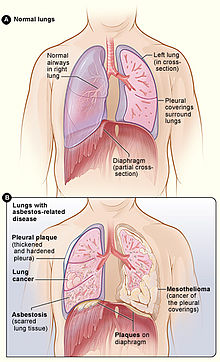| Asbestos-related disease | |
|---|---|
 | |
| Figure A shows the location of the lungs, airways, pleura, and diaphragm in the body. Figure B shows lungs with asbestos-related diseases, including pleural plaque, lung cancer, asbestosis, plaque on the diaphragm, and mesothelioma. | |
| Specialty | Respirology |
Asbestos-related diseases are disorders of the lung and pleura caused by the inhalation of asbestos fibres. Asbestos-related diseases include non-malignant disorders such as asbestosis (pulmonary fibrosis due to asbestos), diffuse pleural thickening, pleural plaques, pleural effusion, rounded atelectasis and malignancies such as lung cancer and malignant mesothelioma.
People who worked in jobs with high asbestos dust exposure are at the highest risk of developing asbestos-related disease. However, exposure to asbestos may also occur in the worker's home due to dust that has accumulated on the worker's clothing (para-occupational exposure). Asbestos-related diseases can also occur as a result of non-occupational, environmental exposure. Asbestos was extensively used in many building materials, therefore large quantities of asbestos still remain in buildings that were built prior to the restriction of asbestos use that applies in many countries. The weathering and aging of such buildings may cause asbestos fragments to be released in the air and create a potential hazard. Anyone who disturbs the asbestos-containing material during home maintenance and renovation can be affected,[1] although the exact risks are difficult to quantify.
- ^ Olsen NJ, Franklin PJ, Reid A, et al. (2011). "Increasing incidence of malignant mesothelioma after exposure to asbestos during home maintenance and renovation". Medical Journal of Australia. 195 (5): 271–274. doi:10.5694/mja11.10125. PMID 21895596.
© MMXXIII Rich X Search. We shall prevail. All rights reserved. Rich X Search
